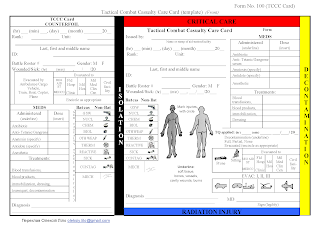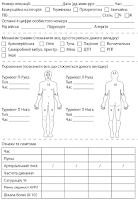Ukraine has become the most heavily mined country in the world, with mines strewn across its northern, eastern, and southern regions, both on land and throughout the Black Sea. This grim reality will inexorably lead to continued civilian casualties from explosive incidents even after cessation of the hostilities. While Russia's war is creating an army of amputees, a conveyor belt of broken bodies, nations across Europe strive to mitigate this human toll. In this endeavor, linguists and translators play an important role, facilitating the evacuation of Ukrainian soldiers with their medical records in their native language.
As time permits, I will try to upload more forms that are frequently requested for translation. If you find an error, have a better translation, or would like to share yours, I would appreciate your feedback: oleksiy.lilo@gmail.com.
Ukrainian Tactical Combat Casualty Care (TCCC) Card, Form 100
Карта пораненого
Первинна медична картка
Форма № 100 (ПМК)
Original Form in Ukrainian (PDF)/(MS Word)
English Translation (PDF)/(MS Word)
Temporary Disability, Exhibit 4
Додаток 4 до Порядку тимчасового звільнення від виконання
службових обов’язків осіб рядового і начальницького складу служби цивільного захисту в разі захворювань, травм або
поранень
ДОВІДКА про тимчасову непрацездатність особи рядового або начальницького складу служби цивільного захисту
Circumstances of Injury, Exhibit 5 + An Example Case
Додаток 5 до Положення про військово-лікарську експертизу
в Збройних силах України
ДОВІДКА про обставини травми (поранення, контузії,
каліцтва)
English Translation (Example Case) (Blank)
Admissions Book (for hospitals and medical volunteers), Form 001/o
Наказ Міністерства охорони здоров’я України 14 лютого
2012 року № 110
МЕДИЧНА ДОКУМЕНТАЦІЯ
Форма первинної облікової документації № 001/о
Discharge Summary, Form 027/o
Форма первинної облікової документації № 027/о
ВИПИСКА із медичної карти амбулаторного (стаціонарного)
хворого
US TCCC Card, DD Form 1380 (JUN 2014), translated into
Ukrainian
Original Form in English (PDF)/(Word)
The front and back of the human body (PNG), if you want to create your own form:
|
|
The majority of the cases I've translated involve amputees. I planned to upload a dozen of the most typical cases, anonymized for confidentiality as follows:
“In the patient's words and according to his medical records, [soldier's name] was injured [date] at [time] near [location] during enemy fire in Russia's war against Ukraine. Pre-med care was administered at the point of injury. The next level of care was the medical company of Military Unit [UIN]. Subsequently evacuated to [MTF name] and underwent the following surgical interventions…”
However, it turns out I am unable to do so due to
non-disclosure agreements and similar contractual limitations. These agreements
prevent me from sharing any of the translated content even in anonymized form.
Nevertheless, I anticipate being able to share more forms, hopefully, some cases too, once I've received
confirmation from the organizations for which I translated them.
Also, sorry about not being able to share the link to this page on Facebook, I can’t either. FB has banned my blog and flagged it as spam, most likely because it is on a free blogging platform. Many users of blogger.com face the same issue. Facebook has not responded to my appeals so far. The blog has even been delisted from Google. Hope Facebook resolves this soon.
|
Поранений XXXXXX, XX роки,
госпіталізований у Військово-медичний клінічний центр Північного регіону МО
України (ВМКЦ ПнР) санітарним транспортом дд.мм.рррр року. Скарги на ниючий біль у ранах на
ділянках передньої черевної стінки, лівої верхній кінцівки, лівої нижньої
кінцівки. З
анамнезу відомо, що постраждалий близько 11-ти годин тому отримав
поранення під час
спрацювання мінно-вибухового пристрою
типу "розтяжка" при
виконанні завдань
антитерористичної
операції (АТО). дд.мм.рррр року
оглянутий лікарем-хірургом
Артемівської ЦРЛ, виконане ПХО ран, видалення стороннього тіла м'яких тканин
(металевого осколку) передньої черевної
стінки живота, оглядова
рентгенографія грудної та
черевної порожнини,
рентгенографія лівої верхній
та лівої нижній
кінцівки у двох
проекціях. На
рентгенографічних знімках грудної
та черевної порожнини
у лівій мезогастральній ділянці виявлено стороннє тіло розміром
0,8×0,5 см, металевої щільності, орієнтовна глибина його розташування 5 см,
іншої патології не виявлено. На
рентгенографічних знімках лівої верхньої та лівої нижньої кінцівок
виявляються множинні сторонні тіла до від 0,3 до 0,6 см у діаметрі, металевої
щільності. Кісно-травматичних
змін не виявлено. Діагноз
при надходженні: вогнепальні
осколкові множинні поєднані сліпі поранення м'яких тканин передньої
черевної стінки живота,
лівої верхньої кінцівки,
лівої нижньої кінцівки
від дд.мм.рррр року. Стан після
ПХО рани м'яких
тканин передньої черевної
стінки живота, видалення стороннього тіла (металевого осколку) від дд.мм.рррр
року. Поранений
госпіталізований у хірургічне відділення клініки торакоабдомінальної хірургії
ВМКЦ ПнР. При
огляді загальний стан задовільний. Шкіряний
покрив та видимі слизові оболонки блідно-рожеві. Пульс
78 удари в 1 хвилину, задовільних характеристик. Серце - тони ритмічні. AT 125/85 мм.
рт. ст. У
легенях дихання везикулярне. Частота
дихань 18 у хвилину. Температура
тіла 36,8 °C. Язик вологий,
обкладений білим нальотом. Живіт м'який,
безболісний. Приглушення у
відлогих місцях черевної
порожнини немає. Перистальтика кишечнику вислуховується, задовільна
(знижена). Живіт
при пальпації м'який, помірно болісний у лівій мезогастральній ділянці. Симптоми Щоткіна-Блюмберга, Куленкампфа, Пастернацького негативні. При
місцевому огляді у лівій
мезогастральній ділянці передньої черевної стінки візуалізується
рана по передній пахвовій лінії розміром 1,5×0,5 см, краї рани рівні, на
лівому плечі по зовнішній поверхні у середній та нижній третині
візуалізуються множинні (біля 20) дотичні рани розміром від 0,2 до 0,5 см; на
лівому стегні та гомілці лівої нижньої кінцівки візуалізуються множинні (біля
30) дотичні рани розміром від 0,2 до 0,5 см. Хворий
взятий у перев'язувальну, де виконана обробка ран розчинами антисептиків. Виконана
невідкладна операція: лапаротомія, ревізія
органів черевної порожнини. При
ревізії виявлено проникаючий
характер поранення, виявлено
дотичне пошкодження стінки тонкої кишки. Рана
кишки ушита дворядними поодиночними вузловими швами. Лаваж
черевної порожнини антисептиками. Силіконовий
двопросвітний дренаж у черевну порожнину до місця операції. Ранній післяопераційний перебіг
без ускладнень. Переведений
для подальшого лікування у задовільному стані. |
Patient XXXXXX, XX y.o.,
admitted to the Military Medical Clinical Center of the Northern Region of
the Ministry of Defense of Ukraine, where he was delivered by an ambulance on
dd/mm/yyyy. Complaints of nagging pain in
the wounds’ areas of the anterior abdominal wall, left upper limb and left
lower limb. According to his medical
history, the casualty sustained injury approximately 11 hours ago from the
detonation of a tripwire explosive device while on active duty in support of
the anti-terrorist operation (ATO). On dd/mm/yyyy, examined by an
operating surgeon at the Artemivsk Central District Hospital. Initial
debridement of the wounds was performed, a foreign object (metal fragment)
was removed from the soft tissues of the anterior wall of the abdomen. Plan
X-ray of the thoracic and abdominal cavities, dual-view X-ray of the left
upper and left lower extremities. The X-ray images of the thoracic
and abdominal cavities revealed a 0.8×0.5 cm foreign object of metallic
density, seated approximately 5 cm deep in the left mesogastric area. No
other pathology found. Radiography of the left upper
and left lower extremities revealed multiple foreign objects having a
metallic density and a diameter between 0.3 and 0.6 cm. No osteo-traumatic changes
found. ADMISSION DIAGNOSIS: On dd/mm/yyyy, received multiple
gunshot fragmentation, concomitant, non-perforating wounds to the soft
tissues of the anterior abdominal wall, left upper extremity and left lower
extremity. Status post initial debridement
of the soft-tissue wound of the anterior wall of the abdomen; extraction of a
foreign object (metal fragment) on dd/mm/yyyy. Patient admitted into the
surgical department of the Thoracoabdominal Surgery Clinic of the Northern
Region Military Medical Clinical Center. On presentation, general state
satisfactory. Skin covering and visible mucous
membranes pale pink. Pulse 78 b/min, satisfactory
data. Heart: rhythmic tones. BP 125/85 mm Hg. Lungs: vesicular breathing. Respiration rate 18 BPM. Body temperature: 36.6°C. Tongue moist, white coated. Abdomen soft, no tenderness. No dullness in the peritoneal
gutters. Bowel sounds heard, peristalsis
satisfactory (reduced). Abdomen soft upon palpation,
moderately tender in the left mesogastric region. Negative for rebound tenderness
(Blumberg), tenderness of the suboccipital muscles (Kulenkampff) and CVA
tenderness (Murphy). Upon local examination, a
1.5×0.5 cm wound is visualized along the anterior axillary line in the left
mesogastric area on the anterior abdominal wall. The edges of the wound are
even. Multiple (approx. 20) tangential wounds, ranging in size between 0.2 and
0.5 cm, are visualized along the outer mid and lower thirds of the left
shoulder; multiple (approx. 30) tangential wounds, between 0.2 and 0.5 cm,
are visualized on the left thigh and left shin. The patient was taken to a
dressing room where the wounds were treated with antiseptic solutions. Urgent surgery performed: laparotomy and abdominoscopy. The examination revealed the
penetrating nature of the injury and tangential damage to the wall of the
small intestine. The wound of the intestine was
closed with double-row single-knotted sutures. Peritoneal lavage with
antiseptics. Abdominal drainage of the
operated site with a dual-lumen silicone tube. No complications during the
early postoperative course. Transferred to the next level of
care in satisfactory condition. |
This may help if you are struggling with terminology related to the Ukrainian MEDEVAC.
Note: I usually prefer ‘medical treatment facility’ (MTF) in this context, but this particular Ukrainian text uses “установа охорони здоров’я”.
|
Першу медичну допомогу
(найпростіші медичні заходи) надають безпосередньо на місці поранення
(ураження) або в найближчому укритті самі військовослужбовці в порядку само-
і взаємодопомоги. Або ж стрільці-санітари, санітари, водії-санітари, бойові
медики та старші бойові медики. |
First aid (basic procedures) is
provided directly at the point of injury or at the nearest place of cover by
military personnel themselves, employing self and buddy aid techniques. It is
also administered by combat lifesavers, corpsmen, drivers/medical aidmen,
combat medics and senior combat medics. |
Feel free to share, comment below, and check back later for
more updates!







дякую за форми!
ReplyDeleteбудь ласка. сподіваюся, вони будуть корисні
Deleteне отображаются картинки под human body (PNG)
ReplyDeleteне работает ссылка Subscribe to
ReplyDeleteСпасибо!!!
ReplyDeleteспасибо, починил
ReplyDeleteДякую!)
ReplyDelete